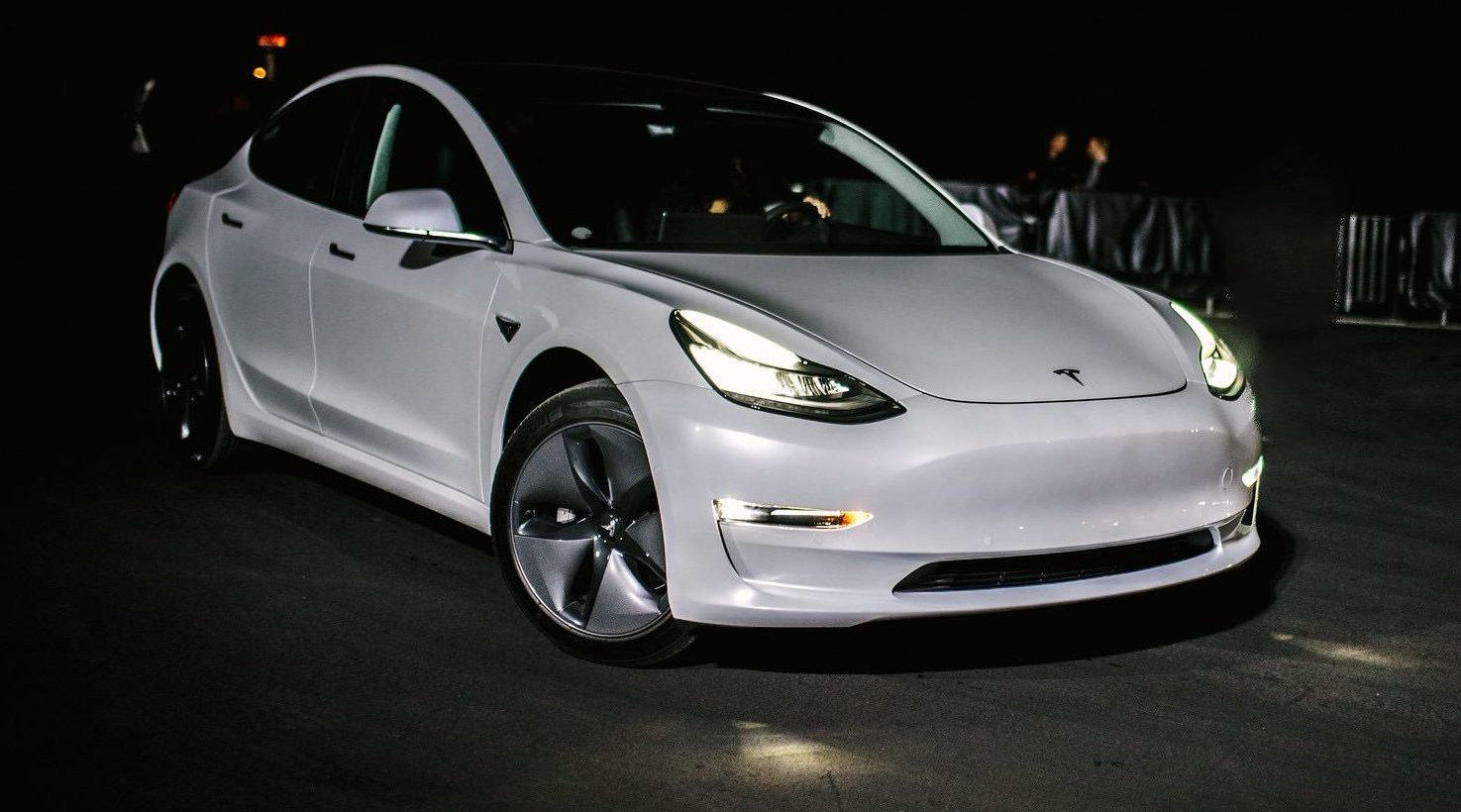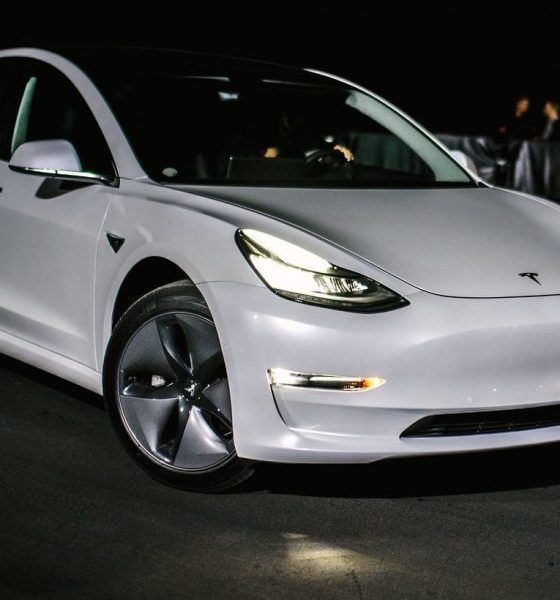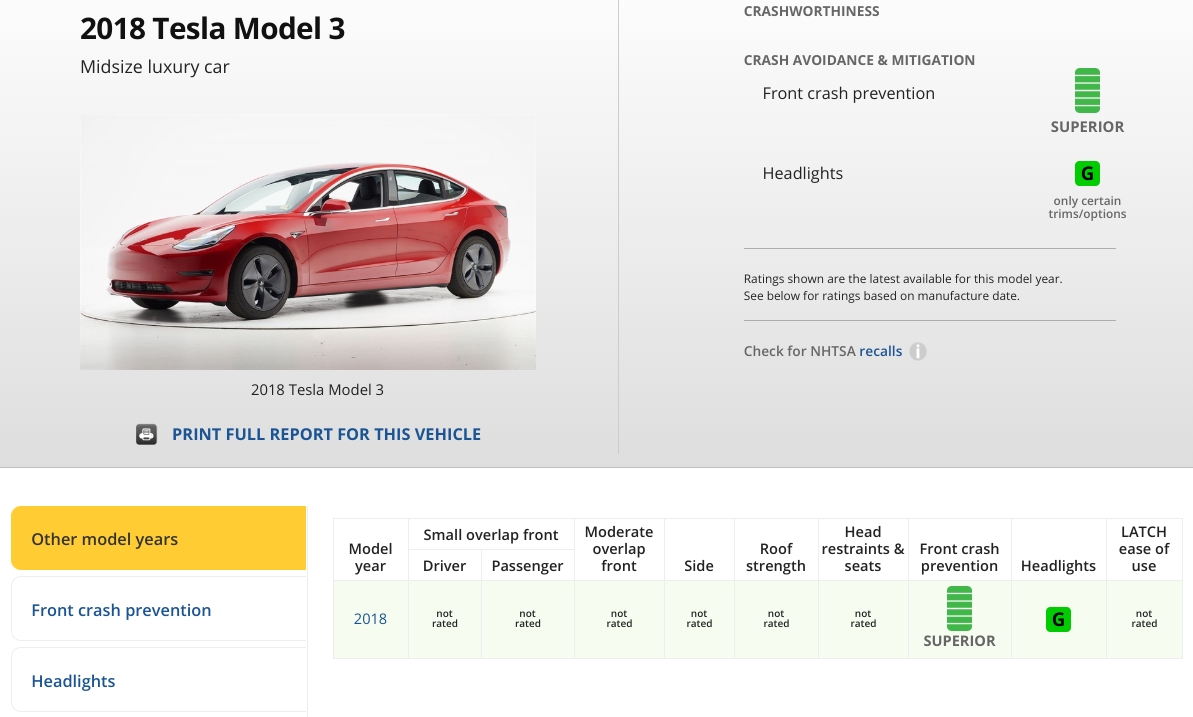

Investor's Corner
Tesla Model 3 headlights gain the IIHS’ elusive ‘Good’ rating after design update
Earlier this year, the Insurance Institute for Highway Safety (IIHS), a nonprofit organization dedicated to reducing the number of accidents and injuries on the road, awarded the Tesla Model 3’s headlights with an “Acceptable” rating. While the IIHS’ tests gave a “Superior” rating for the vehicle’s front crash avoidance features then, the safety organization only listed the vehicle’s headlights as “Acceptable,” due to glaring issues from the Model 3’s low beams.
In a recent Twitter announcement, though, the IIHS noted that the Tesla Model 3 now earns a “Good” rating for its standard LED reflector headlights. The IIHS stated that the vehicle’s improved, updated score reflects the headlights of Model 3 that were produced after June 2018, a time when Tesla was starting to hit its stride with the production of the electric sedan.
The IIHS’ updated results could be seen in the Model 3’s page on the nonprofit’s website. So far, though, the IIHS has not released the Model 3’s official full safety ratings, which include metrics such as “Roof Strength” and “LATCH ease of use.”

That said, the Model 3’s “Good” rating for its headlights says a lot about Tesla’s focus on designing an incredibly safe electric car. The IIHS, after all, utilizes one of the strictest metrics for testing headlights. The headlights of the Tesla Model S, for one, were given a “Poor” rating by the IIHS. The Chevy Bolt EV’s headlights, which are incredibly bright, were also rated as “Poor.”
The IIHS evaluates headlights based on the lamps’ reach as the vehicle travels on straight and curved lines. Low beams are measured on five approaches — straightaways, left and right curves on an 800-foot radius, and sharp left and right curves on a 500-foot radius. The IIHS weighs low beams more heavily than high beams since they are used more often when driving. During the Model 3’s initial tests earlier this year, the vehicle’s low beams exhibited a 15.2% glare during straightways, preventing the Model 3 from earning the IIHS’ “Good” rating. As noted by the IIHS, this particular issue was addressed in Model 3 produced after Q2 2018.
The updated score of the Model 3’s headlights highlights Tesla’s unique tendency to update its vehicles as soon as improvements are available. This was pointed out by Elon Musk on Twitter, when he stated that when it comes to Tesla’s electric cars, there is “no such thing as a full refresh” since all vehicles are “partially upgraded every month as soon as a new subsystem is ready for production.” This practice was also mentioned by Tesla President of Automotive Jerome Guillen in an interview with CNBC, when he noted that the company’s technology is always in a process of evolution.
The 2018 Tesla Model 3 now earns a good rating for its standard LED reflector headlights for models built after June 2018. Previous models earn an acceptable rating. https://t.co/EUWXFLBnkm pic.twitter.com/TOctSTGaAl
— IIHS (@IIHS_autosafety) December 26, 2018
In a statement to CNET, IIHS senior vice president for communications Russ Rader explained the organization’s focus on headlights as a metric for vehicle safety. Rader also noted that headlights must be seen not just as a decorative component of a vehicle. Instead, they should be perceived as safety equipment.
“When one vehicle’s low beams only illuminate the right side of a straightaway for 148 feet, and another vehicle’s low beams allow a driver to see more than twice as far, there’s a problem. IIHS has incorporated headlight performance into our Top Safety Pick awards. We’re already seeing manufacturers make improvements, especially tightening up aim at the factory. Headlights shouldn’t just be about what looks cool. They’re important safety equipment. When they perform well, they can help drivers spot trouble sooner and avoid a crash.”
Apart from the IIHS, the Model 3 is also gaining accolades from other safety organizations. The National Highway Traffic Safety Administration (NHTSA), for one, has given the Model 3 a flawless 5-Star Safety Rating. The organization tested the Model 3 on frontal crash, side crash, and rollover safety; and in all categories and subcategories, the electric car displayed a level of industry-leading driver and passenger safety. As highlighted by Tesla in a following blog post, the scores of the Model 3 from the NHTSA’s tests place the electric car as the vehicle with the “lowest probability of injury” among all cars tested by the NHTSA to date.

Investor's Corner
Tesla stock closes at all-time high on heels of Robotaxi progress

Tesla stock (NASDAQ: TSLA) closed at an all-time high on Tuesday, jumping over 3 percent during the day and finishing at $489.88.
The price beats the previous record close, which was $479.86.
Shares have had a crazy year, dipping more than 40 percent from the start of the year. The stock then started to recover once again around late April, when its price started to climb back up from the low $200 level.
This week, Tesla started to climb toward its highest levels ever, as it was revealed on Sunday that the company was testing driverless Robotaxis in Austin. The spike in value pushed the company’s valuation to $1.63 trillion.
Tesla Robotaxi goes driverless as Musk confirms Safety Monitor removal testing
It is the seventh-most valuable company on the market currently, trailing Nvidia, Apple, Alphabet (Google), Microsoft, Amazon, and Meta.
Shares closed up $14.57 today, up over 3 percent.
The stock has gone through a lot this year, as previously mentioned. Shares tumbled in Q1 due to CEO Elon Musk’s involvement with the Department of Government Efficiency (DOGE), which pulled his attention away from his companies and left a major overhang on their valuations.
However, things started to rebound halfway through the year, and as the government started to phase out the $7,500 tax credit, demand spiked as consumers tried to take advantage of it.
Q3 deliveries were the highest in company history, and Tesla responded to the loss of the tax credit with the launch of the Model 3 and Model Y Standard.
Additionally, analysts have announced high expectations this week for the company on Wall Street as Robotaxi continues to be the focus. With autonomy within Tesla’s sights, things are moving in the direction of Robotaxi being a major catalyst for growth on the Street in the coming year.
Elon Musk
Tesla needs to come through on this one Robotaxi metric, analyst says
“We think the key focus from here will be how fast Tesla can scale driverless operations (including if Tesla’s approach to software/hardware allows it to scale significantly faster than competitors, as the company has argued), and on profitability.”

Tesla needs to come through on this one Robotaxi metric, Mark Delaney of Goldman Sachs says.
Tesla is in the process of rolling out its Robotaxi platform to areas outside of Austin and the California Bay Area. It has plans to launch in five additional cities, including Houston, Dallas, Miami, Las Vegas, and Phoenix.
However, the company’s expansion is not what the focus needs to be, according to Delaney. It’s the speed of deployment.
The analyst said:
“We think the key focus from here will be how fast Tesla can scale driverless operations (including if Tesla’s approach to software/hardware allows it to scale significantly faster than competitors, as the company has argued), and on profitability.”
Profitability will come as the Robotaxi fleet expands. Making that money will be dependent on when Tesla can initiate rides in more areas, giving more customers access to the program.
There are some additional things that the company needs to make happen ahead of the major Robotaxi expansion, one of those things is launching driverless rides in Austin, the first city in which it launched the program.
This week, Tesla started testing driverless Robotaxi rides in Austin, as two different Model Y units were spotted with no occupants, a huge step in the company’s plans for the ride-sharing platform.
Tesla Robotaxi goes driverless as Musk confirms Safety Monitor removal testing
CEO Elon Musk has been hoping to remove Safety Monitors from Robotaxis in Austin for several months, first mentioning the plan to have them out by the end of 2025 in September. He confirmed on Sunday that Tesla had officially removed vehicle occupants and started testing truly unsupervised rides.
Although Safety Monitors in Austin have been sitting in the passenger’s seat, they have still had the ability to override things in case of an emergency. After all, the ultimate goal was safety and avoiding any accidents or injuries.
Goldman Sachs reiterated its ‘Neutral’ rating and its $400 price target. Delaney said, “Tesla is making progress with its autonomous technology,” and recent developments make it evident that this is true.
Investor's Corner
Tesla gets bold Robotaxi prediction from Wall Street firm
Last week, Andrew Percoco took over Tesla analysis for Morgan Stanley from Adam Jonas, who covered the stock for years. Percoco seems to be less optimistic and bullish on Tesla shares, while still being fair and balanced in his analysis.

Tesla (NASDAQ: TSLA) received a bold Robotaxi prediction from Morgan Stanley, which anticipates a dramatic increase in the size of the company’s autonomous ride-hailing suite in the coming years.
Last week, Andrew Percoco took over Tesla analysis for Morgan Stanley from Adam Jonas, who covered the stock for years. Percoco seems to be less optimistic and bullish on Tesla shares, while still being fair and balanced in his analysis.
Percoco dug into the Robotaxi fleet and its expansion in the coming years in his latest note, released on Tuesday. The firm expects Tesla to increase the Robotaxi fleet size to 1,000 vehicles in 2026. However, that’s small-scale compared to what they expect from Tesla in a decade.
Tesla expands Robotaxi app access once again, this time on a global scale
By 2035, Morgan Stanley believes there will be one million Robotaxis on the road across multiple cities, a major jump and a considerable fleet size. We assume this means the fleet of vehicles Tesla will operate internally, and not including passenger-owned vehicles that could be added through software updates.
He also listed three specific catalysts that investors should pay attention to, as these will represent the company being on track to achieve its Robotaxi dreams:
- Opening Robotaxi to the public without a Safety Monitor. Timing is unclear, but it appears that Tesla is getting closer by the day.
- Improvement in safety metrics without the Safety Monitor. Tesla’s ability to improve its safety metrics as it scales miles driven without the Safety Monitor is imperative as it looks to scale in new states and cities in 2026.
- Cybercab start of production, targeted for April 2026. Tesla’s Cybercab is a purpose-built vehicle (no steering wheel or pedals, only two seats) that is expected to be produced through its state-of-the-art unboxed manufacturing process, offering further cost reductions and thus accelerating adoption over time.
Robotaxi stands to be one of Tesla’s most significant revenue contributors, especially as the company plans to continue expanding its ride-hailing service across the world in the coming years.
Its current deployment strategy is controlled and conservative to avoid any drastic and potentially program-ruining incidents.
So far, the program, which is active in Austin and the California Bay Area, has been widely successful.








